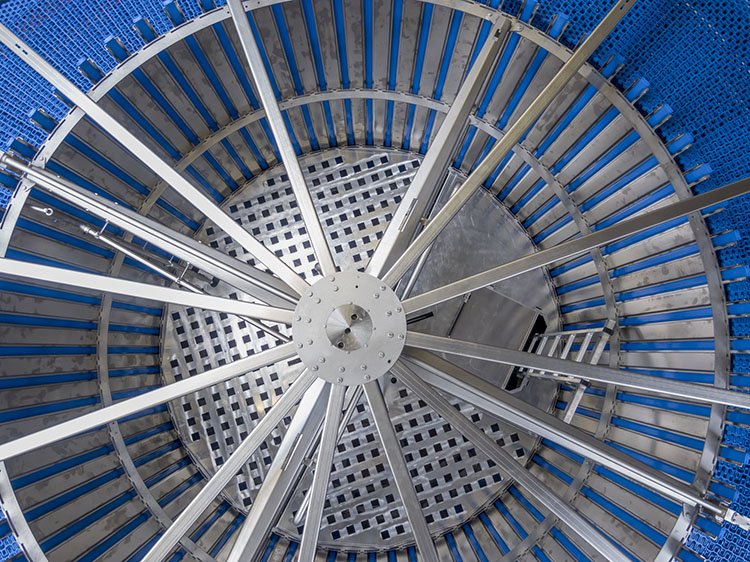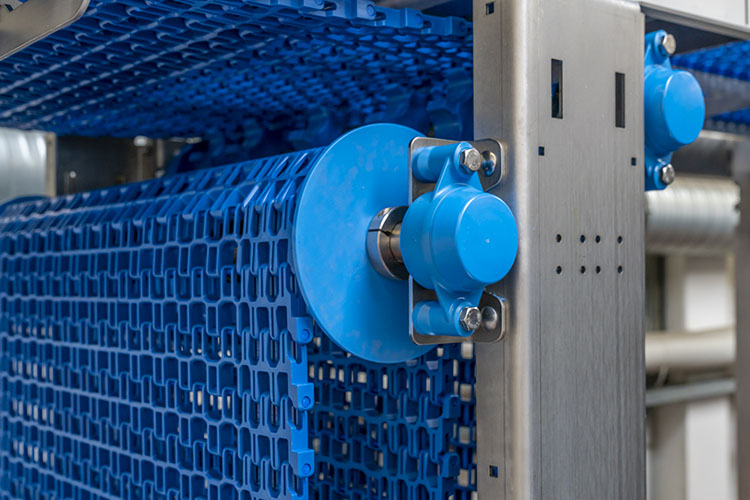

The airflow in Heinen cooling and freezing equipment is generated by frequency-controlled fans that blow the air horizontally through the system. An open airflow through the system ensures that the product comes into contact with the cold air from all sides. “An open and product-oriented air flow is the basic concept of the acticool,” he illustrates. To avoid too sharp and fast airflows, Heinen uses frequency-controlled fans, with a unique wing design. The company’s managing director details: “It is a bionic wing design based on the wings of owls; they are designed this way to save energy and make less noise.” Airflow intensity is among the parameters included in the product recipes saved into the machine. The acticool normally operates with temperatures around +20°C. Lower temperatures can dry out the product and the system tends to produce condensation if it is too warm.
Into the spiral cooler
Spiral coolers require specific cooling and heating media. For cooling, this medium can be any kind of refrigerant, glycol, or cold water, depending on immediate availability. A closed airflow system and a heating medium are also needed. The specialist goes on to elaborate that, “In a closed system, we also have to eliminate the humidity leaving the product. We control the condensation at the air cooler and reheat afterward as needed.” Energy consumption can be lowered by using outside air for eliminating humidity instead of the condensation principle and by reducing the pressure loss of all involved components. This means wide fin spacing at the air cooler and baffling plates with little or no air, as well as well-synchronized components,” Hottinger adds.
There are two reasons behind the design of Heinen spiral coolers without air guide elements. First of all, slow air movement in the system is the better alternative for treating the products as gently as possible, as it uses no direct, forced-air stream. “It should be more like a light breeze touching the product from everywhere. If you have air baffling plates, the air speeds up and aggressively engulfs the product, which can dry out the surface,” explains Hottinger. Secondly, forcing air to go in a certain direction leads to higher energy consumption, because of air pressure loss as it is forced along the baffling plates.
At the core of any spiral system is its belt. Heinen’s spiral coolers use modular plastic belts with their inherent advantages in the process: they are lighter, help save energy, are easy to repair and are more reliable. Since they weigh less, they are also less prone to friction. “As machine builders, we prefer light, plastic belts as they require less force to run in the system which adds up to smaller drives and lower energy consumption, respectively,” Hottinger shares. Spirals are also known for their flexibility in layout options. Heinen customizes them, especially for bakeries, with designs that match the factory or process layout. “If a double drum twin belt system is needed, Heinen can do this as well. We will recommend the one that best fits the customer’s layout because it will benefit them the most,” he explains.

Powered by frequency converters
On all Heinen spiral systems, from active spiral coolers, or spiral proofers to spiral freezers, all fans are run via frequency converters, which means that they can be adjusted according to the individual needs of every product. Some of the latest features that Heinen has brought to its spirals include options to enhance the cleaning process. “We have redesigned major parts of the machine so that they are self-draining, easy to access and can be disassembled without tools,” Heinen’s specialist highlights. For example, the newly-launched freezerfoamer PRO series is a pump unit connected to Heinen’s integrated cleaning system, which saves water and detergents during the cleaning process. The freezerfoamer PRO, in combination with the cleaning system, adjusts water pressure, detergent concentration and foam consistency on each nozzle head and nozzle bar. The investment is amortized by the savings made over time in water and detergents. A complete record of the entire cleaning process is also available with this system.
One of the mottos of Heinen’s design team is that ‘the best spiral freezer has not been built yet’, and that they are continuously under development. This is something the company has learned in over 40 years of working on proofers, coolers and freezers: there is always room for improvement and always a next step. It will be interesting to learn what the future will bring in the world of cooling and freezing. Heinen anticipates that the next generation of proofers, coolers and freezers will precisely and continuously adjust to the actual demands of the processed product and point out further optimization and efficiency opportunities. The future sounds ‘cool’.

Formulating and perfecting the recipe is only the start to having great-tasting, crunchy or soft bakery products. The freezing process is essential to how their properties will be captured and preserved.
Cooling efficiency: acticool
Cold-generating equipment is continuously improved for optimized process efficiency. For Heinen, this means their active spiral cooler – acticool®, the proofline® spiral proofer and their spiral freezer, called arctic. The company places emphasis on precision in the coiling process to meet process demands from bakeries. There are numerous cooling applications in the bakery industry and not all require precision, such as in the case of precooling products for freezing them at a later time. However, in certain areas (for example, freshly sliced bread), “Absolute temperature accuracy is necessary,” says Jochen Hottinger, Managing Director, Heinen Freezing GmbH & Co. KG. If the product is too hot, then the slicing machines tend to smear and destroy the product. If the product is too cold, the slicing process shatters the crust, causing both unnecessary product loss and the unappealing appearance of the cut product. To this, he adds: “Therefore, we thought about how we could improve the accuracy of our temperature control system. We have changed the number and position of sensors in our system, the control systems (by improving our in-house built PID software controllers) and the airflow through the system – here, our aim was to avoid all unnecessary air baffling plates and air resistance in the system.”
The article is part of an extended feature, which was originally published in [BBI 5 – 2022]. Read the full article in the magazine:


